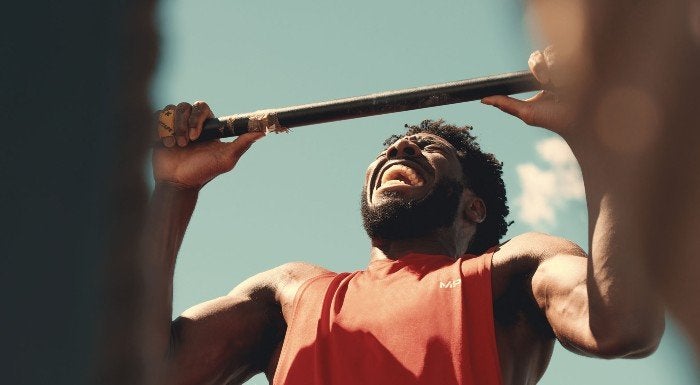Master The Wide Grip Pull-Up

The pull-up is a great compound movement to fit into your training routine. It’s great for building strength, but it can be a hard exercise to get to grips with, especially when you’re just getting started.
Holding and controlling your own body weight is an amazing ability to have, but it can seem some way away if you’re not there yet hanging off the bar. Since you’re fighting against yourself, there aren’t many ways to make the pull-up easier. But there are a couple of ways to build up your strength and make it there.
Muscles Worked During a Wide-Grip Pull-Up
The main muscles worked during a pull-up are the lats (latissimus dorsi), the large muscles that go from your arms to your mid-back that can give you a wing or triangle-like shape from shoulders to waist.
These muscles are essential for bringing your elbows down towards your sides. The biceps will also be used to flex at the elbow and bend the arm.
As well as these primary muscles engaging to move you up towards the bar, other muscles are needed to support and control the movement. In the back, the rhomboids, teres major, rear delts are involved. The forearm muscles assist with grip and help bend the arm.
And don’t forget the core and glutes, which help stabilise the body to make the movement easier.

Wide-Grip vs Close-Grip Pull-Ups
There are many pull-up variations, but the most common ones use a wider or narrower (closed) grip on a flat bar. You may also see bars with looped grips that allow for a neutral grip with palms facing each other.
The wider the grip, the more the back will be engaged, particularly the lats, and more tension will go through those muscles.
If you choose a narrower grip, you’ll find the movement might work your biceps more, as well as the teres major and rhomboids in your back.
You might find some differences in difficulty between grip-width. This comes down to your dominant muscles and the structure of your physique.
For example, if you go too wide, the angle becomes very hard due to the lever you create at the shoulder. If you go too narrow, the distance to travel increases, presenting a different challenge.
So, although they differ, it is good to keep practicing both to challenge yourself and develop your strength in several ways.
How to Build Up Strength for the Wide-Grip Pull-Up
Wide-grip pull-downs
If you’re struggling with wide-grip pull-ups, a pull-down is a great place to start as it mimics the same movements and works the same muscles.
Start off building a good foundation for the movement, with a grip wider than shoulder-width. Complete 12 reps for three sets on week one, then increase the weight every week while decreasing the reps.
Once you’re close to lifting your own body weight, move onto the pull-up bar.
Narrow grip pull-ups
If you can’t get a handle on the wider grip movement, you may find it easier starting with a narrower grip. You could aim for a closer grip or use a neutral grip to put your shoulders in a stronger position.
Alternatively, you could reverse your grip to move through a stronger range of motion with your elbows closer to you. Focus on pulling your elbows down to your sides rather than getting your chin over the bar.
Negative pull-ups
This exercise takes you through the same movement as the pull-up but only using the downward or negative (eccentric) phase of the movement.
Because it’s easier to control a movement in the negative phase, you can get a lot of improvement from training it in isolation.
Set up a bench under the pull-up bar so you can stand on it and jump to the top of the pull-up. Hold there for a second and slowly lower yourself back down trying to make the movement last for six seconds. Repeat for three sets of four reps.
Banded pull-ups
Resistance bands can be a great way to adapt movements so that the hardest parts become more manageable.
Starting from a straight arm hang can feel nearly impossible, but using a resistance band can help get you started, almost like a slingshot pushing you up.
As the band gets shorter, you get less support, but it does help get the movement started.

How to Do a Wide-Grip Pull-Up
The setup for the pull-up is quite simple. The only equipment you need is a bar that you can hang from with enough room above so you don’t hit your head.
Hold onto the bar with an overhand grip slightly outside of shoulder-width.
Pull your shoulder blades back and down as if you’re trying to tuck them into your back pockets.
Draw in your belly button and squeeze your glutes.
Start to pull yourself towards the bar, pulling your elbows down and towards your sides.
Lift your chest to the bar to fully engage your back.
Control the movement back down to a hanging position and start again.
If it’s too easy you can use a weight belt to add some weight.
Alternatives to the Wide-Grip Pull-Up
If you can’t find a bar or you’re looking for an alternative or an accessory exercise, try filling up your workout with a couple of variations. Attempt them a couple of times per week to build up to around 20 sets of back training per week.
Single-arm row: Holding a single dumbbell with one knee and hand supported on a bench and the other foot on the floor, pull your elbow up to your side in a sawing motion.
Ring pull-ups: These are a great addition to equipment to use if you have access to the equipment. The rings allow for a different range of movement and additional rotation at the shoulder, helping to build up the joint strength.
Bent-over row: This exercise can be performed with a bar in a bent-over position and works the same muscles. It can also be performed in a reverse grip to work the lats a little more.
FAQs about wide-grip pull-ups
How many reps and sets should I do with a wide-grip pull-up?
This depends on your overall goal. If you want to build strength, 3-5 reps for 3-5 sets will help as long as you are fatiguing in this rep range. You may need to increase the weight to achieve this.
However, if you are not used to the movement, it might be better to build up a foundation with higher reps of around 12 for 2-3 sets.
Are wide-grip pull-ups better than normal pull-ups?
A wider grip can help to build a wider back if you are able to perform it, but that doesn’t make it better. It can sometimes be more difficult so you may not be able to perform as many reps. If this is the case, a standard pull-up might stimulate the muscles for longer.
Is a wider grip harder for pull-ups?
This can depend on limb length, the structure of your muscles and where they attach, and even the biomechanics of your own movement. The best thing to do is try it for yourself to see.
Do pulls-ups give you a wide back?
Because of the muscles they work (including the lats and teres major), pull-ups can help to increase the size of your back, including width.
They also help due to strengthening your posture with the engagement of your rhomboids to pull your shoulder blades back.
Take Home Message
Wide-grips pull-ups are hard, but with regular practice you should be able to get the hang of them. Complete them early in your workouts when you’re not fatigued, and make sure to include plenty of variations and accessory movements to develop your overall strength.
EXERCISE ARTICLES HERE:

Origin Pre-Workout: Fuel For The Dedicated
Pop a scoop, wrap up your straps, and get lifting.

Nathaniel Massiah Weekly Workout Split
With just four sessions a week, we can guarantee Nathaniel goes hard.

Best Whey Protein | The Difference Between Impact Whey & Impact Whey Isolate?
It's a battle of the best.

Simon started his fitness journey from a young age, and was playing sport as soon as he could roll a ball. This pushed him to compete in a variety of sports from rugby to squash.
After completing an MSc in Strength & Conditioning, alongside a PT qualification, he gained an academic role at the University of Chester. From lecturing to research-based studies, his applied role caters to both team and individual sports.






